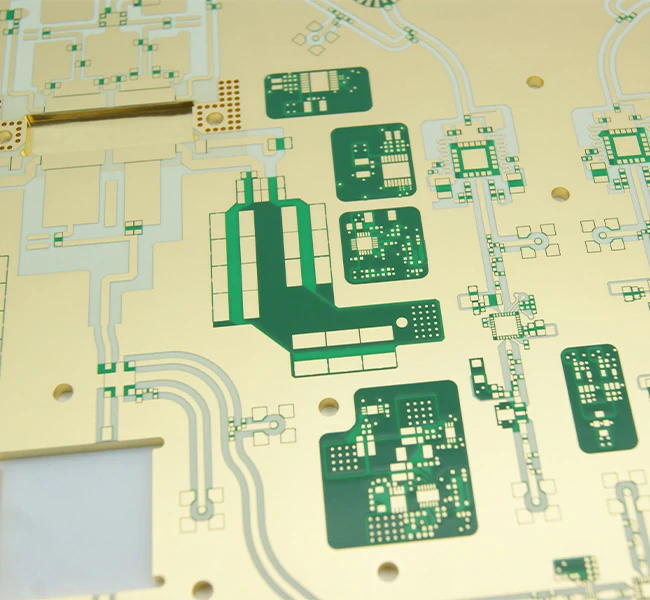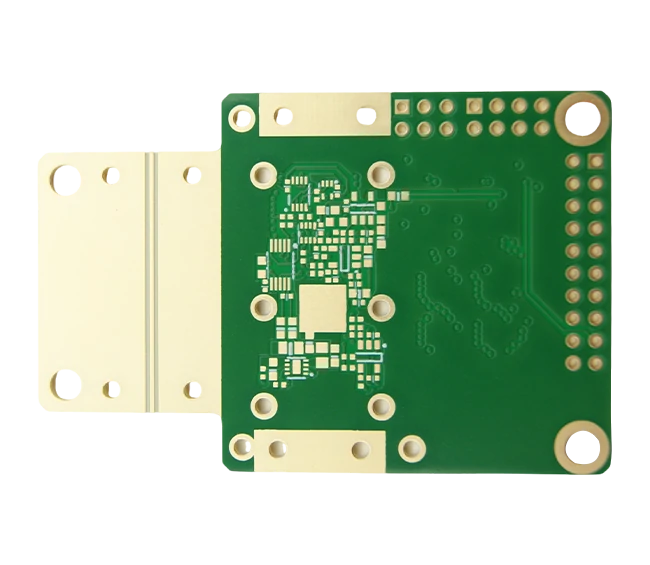Hybrid Printed Circuit Boards (Hybrid PCBs)
The High-Performance Engine Empowering Next-Gen Electronics As global electronics evolve toward high-frequency, high-speed, and high-integration demands, Hybrid PCBs have emerged as a cornerstone technology for 5G communications, AI computing, autonomous driving, and beyond. By strategically combining materials with distinct dielectric properties, Hybrid PCBs break the limitations of traditional PCBs, achieving an optimal balance of performance, cost, and reliability. Here’s an in-depth exploration of their value proposition, applications, and future trends.
Core Technical Advantages: Precision, Efficiency, and Cost Optimization
High-Frequency Signal Integrity Hybrid PCBs integrate high-speed materials (e.g., Rogers RO4350B, PTFE) with cost-effective FR-4 substrates. For instance, in 5G base stations, high-frequency layers (Dk=3.48, Df=0.003) enable millimeter-wave signal transmission, while power layers use FR-4, reducing signal attenuation by over 50% compared to pure FR-4 designs.
Dynamic Impedance Control and Thermal Management Advanced simulation tools (e.g., HFSS, ADS) ensure impedance continuity across material layers, with tolerances as tight as ±3Ω for 40GHz radar systems. Embedded aluminum or ceramic substrates enhance thermal conductivity (up to 1.2W/mK), ideal for high-power chips like GPUs.
Cost-Effective Material Utilization Selective use of high-performance materials only on critical layers cuts costs by 30–40%. For example, automotive 77GHz radar modules apply high-frequency laminates to antenna layers while employing FR-4 for data processing, balancing performance and budget.



Industry Applications: Powering Innovation Across Sectors
5G and Satellite Communications Hybrid PCBs support massive MIMO antennas and RF front-end modules, reducing insertion loss to ≤0.18dB/cm and extending base station coverage by 15%. Leading telecom giants like Huawei leverage Rogers RO4835+FR-4 stacks for sub-6GHz and mmWave networks.
Autonomous Vehicles and ADAS In L4 autonomous systems, Hybrid PCBs integrate 77GHz radar and LiDAR control modules. High-speed layers (e.g., RO3003+FR-4) achieve 300-meter detection accuracy while withstanding extreme temperatures (-40°C to 125°C).
AI Servers and HPC NVIDIA’s DGX series utilizes 26-layer hybrid stacks with Ultra Low Loss laminates (Df=0.001) and HDI technology, enabling 112Gbps SerDes transmission and 40% higher compute density.
Consumer Electronics and IoT Foldable smartphones employ polyimide-based hybrid designs for 360° bend cycles exceeding 200,000, while IoT sensors use embedded components to shrink PCB sizes by 30%.
Manufacturing Breakthroughs: Precision and Sustainability
Advanced Lamination and Drilling Stepwise lamination (low-temperature FR-4 pre-press + high-frequency material curing) minimizes layer misalignment (<25μm). Laser drilling achieves 25μm precision, supporting 20-layer HDI boards.
AI-Driven Quality Assurance DFM systems detect 200+ design flaws automatically, while AOI and TDR testing ensure ±5% impedance consistency, boosting yields to 99.5%.
Eco-Friendly Innovations “Pseudo-FR-4” materials with boron nitride fillers reduce Dk to 3.2 and Df to 0.002, cutting carbon emissions by 20%.
Future Trends: Redefining Standards for Next-Gen Tech
Material Innovation Modified epoxy resins and liquid crystal polymers (LCP) aim for Dk≤2.8 and CTE matching within ±2ppm/°C.
Photonics-Electronics Convergence 3D-printed hybrid boards with embedded optical waveguides and thermal channels will support terahertz communications and quantum computing.
Market Expansion The global PCB market is projected to reach $97.7 billion by 2033, driven by Hybrid PCB adoption in AI, 6G, and brain-computer interfaces.
Conclusion
Hybrid PCBs represent not just a technological leap but a strategic advantage in the global electronics race. From Shenzhen’s manufacturing hubs to global R&D centers, Hybrid PCB innovation is reshaping industries. By embracing Hybrid PCBs, businesses unlock smarter designs, unmatched reliability, and a sustainable edge in the era of intelligent connectivity.

